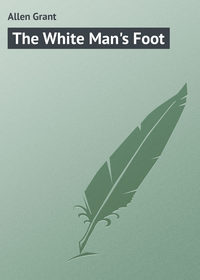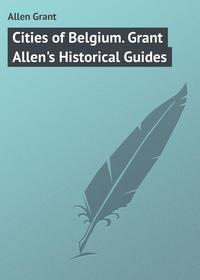 полная версия
полная версияScience in Arcady
In India, for example, there are no cactuses. But I wouldn't advise you to dispute the point with a peppery, fire-eating Anglo-Indian colonel. I did so once, myself, at the risk of my life, at a table d'hôte on the Continent; and the wonder is that I'm still alive to tell the story. I had nothing but facts on my side, while the colonel had fists, and probably pistols. And when I say no cactuses, I mean, of course, no indigenous species; for prickly pears and epiphyllums may naturally be planted by the hand of man anywhere. But what people take for thickets of cactus in the Indian jungle are really thickets of cactus-like spurges. In the dry soil of India, many spurges grow thick and succulent, learn to suppress their leaves, and assume the bizarre forms and quaint jointed appearance of the true cactuses. In flower and fruit, however, they are euphorbias to the end; it is only in the thick and fleshy stem that they resemble their nobler and more beautiful Western rivals. No true cactus grows truly wild anywhere on earth except in America. The family was developed there, and, till man transplanted it, never succeeded in gaining a foothold elsewhere. Essentially tropical in type, it was provided with no means of dispersing its seeds across the enormous expanse of intervening ocean which separated its habitat from the sister continents.
But why are cactuses so almost universally prickly? From the grotesque little melon-cactuses of our English hothouses to the huge and ungainly monsters which form miles of hedgerows on Jamaican hillsides, the members of this desert family are mostly distinguished by their abundant spines and thorns, or by the irritating hairs which break off in your skin if you happen to brush incautiously against them. Cactuses are the hedgehogs of the vegetable world; their motto is Nemo me impune lacessit. Many a time in the West Indies I have pushed my hand for a second into a bit of tangled 'bush,' as the negroes call it, to seize some rare flower or some beautiful insect, and been punished for twenty-four hours afterwards by the stings of the almost invisible and glass-like little cactus-needles. When you rub them they only break in pieces, and every piece inflicts a fresh wound on the flesh where it rankles. Some of the species have large, stout prickles; some have clusters of irritating hairs at measured distances; and some rejoice in both means of defence at once, scattered impartially over their entire surface. In the prickly pear, the bundles of prickles are arranged geometrically with great regularity in a perfect quincunx. But that is a small consolation indeed to the reflective mind when you've stung yourself badly with them.
The reason for this bellicose disposition on the part of the cactuses is a tolerably easy one to guess. Fodder is rare in the desert. The starving herbivores that find themselves from time to time belated on the confines of such thirsty regions would seize with avidity upon any succulent plant which offered them food and drink at once in their last extremity. Fancy the joy with which a lost caravan, dying of hunger and thirst in the byways of Sahara, would hail a great bed of melons, cucumbers, and lettuces! Needless to say, however, under such circumstances melon, cucumber, and lettuce would soon be exterminated: they would be promptly eaten up at discretion without leaving a descendant to represent them in the second generation. In the ceaseless war between herbivore and plant, which is waged every day and all day long the whole world over with far greater persistence than the war between carnivore and prey, only those species of plant can survive in such exposed situations which happen to develop spines, thorns, or prickles as a means of defence against the mouths of hungry and desperate assailants.
Nor is this so difficult a bit of evolution as it looks at first sight. Almost all plants are more or less covered with hairs, and it needs but a slight thickening at the base, a slight woody deposit at the point, to turn them forthwith into the stout prickles of the rose or the bramble. Most leaves are more or less pointed at the end or at the summits of the lobes; and it needs but a slight intensification of this pointed tendency to produce forthwith the sharp defensive foliage of gorse, thistles, and holly. Often one can see all the intermediate stages still surviving under one's very eyes. The thistles, themselves, for example, vary from soft and unarmed species which haunt out-of-the-way spots beyond the reach of browsing herbivores, to such trebly-mailed types as that enemy of the agricultural interest, the creeping thistle, in which the leaves continue themselves as prickly wings down every side of the stem, so that the whole plant is amply clad from head to foot in a defensive coat of fierce and bristling spearheads. There is a common little English meadow weed, the rest-harrow, which in rich and uncropped fields produces no defensive armour of any sort; but on the much-browsed-over suburban commons and in similar exposed spots, where only gorse and blackthorn stand a chance for their lives against the cows and donkeys, it has developed a protected variety in which some of the branches grow abortive, and end abruptly in stout spines like a hawthorn's. Only those rest-harrows have there survived in the sharp struggle for existence which happened most to baffle their relentless pursuers.
Desert plants naturally carry this tendency to its highest point of development. Nowhere else is the struggle for life so fierce; nowhere else is the enemy so goaded by hunger and thirst to desperate measures. It is a place for internecine warfare Hence, all desert plants are quite absurdly prickly. The starving herbivores will attack and devour under such circumstances even thorny weeds, which tear or sting their tender tongues and palates, but which supply them at least with a little food and moisture: so the plants are compelled in turn to take almost extravagant precautions. Sometimes the leaves end in a stout dagger-like point, as with the agave, or so-called American aloe; sometimes they are reduced to mere prickles or bundles of needle-like spikes; sometimes they are suppressed altogether, and the work of defence is undertaken in their stead by irritating hairs intermixed with caltrops of spines pointing outward from a common centre in every direction. When one remembers how delicately sensitive are the tender noses of most browsing herbivores, one can realize what an excellent mode of defence these irritating hairs must naturally constitute. I have seen cows in Jamaica almost maddened by their stings, and even savage bulls will think twice in their rage before they attempt to make their way through the serried spears of a dense cactus hedge. To put it briefly, plants have survived under very arid or sandy conditions precisely in proportion as they displayed this tendency towards the production of thorns, spines, bristles, and prickles.
It is a marked characteristic of the cactus tribe to be very tenacious of life, and when hacked to pieces, to spring afresh in full vigour from every scrap or fragment. True vegetable hydras, when you cut down one, ten spring in its place: every separate morsel of the thick and succulent stem has the power of growing anew into a separate cactus. Surprising as this peculiarity seems at first sight, it is only a special desert modification of a faculty possessed in a less degree by almost all plants and by many animals. If you cut off the end of a rose branch and stick it in the ground under suitable conditions, it grows into a rose tree. If you take cuttings of scarlet geraniums or common verbenas, and pot them in moist soil, they bud out apace into new plants like their parents. Certain special types can even be propagated from fragments of the leaf; for example, there is a particularly vivacious begonia off which you may snap a corner of one blade, and hang it up by a string from a peg or the ceiling, when, hi, presto! little begonia plants begin to bud out incontinently on every side from its edges. A certain German professor went even further than that; he chopped up a liverwort very fine into vegetable mincemeat, which he then spread thin over a saucerful of moist sand, and lo! in a few days the whole surface of the mess was covered with a perfect forest of sprouting little liverworts. Roughly speaking, one may say that every fragment of every organism has in it the power to rebuild in its entirety another organism like the one of which it once formed a component element.
Similarly with animals. Cut off a lizard's tail, and straightway a new tail grows in its place with surprising promptitude. Cut off a lobster's claw, and in a very few weeks that lobster is walking about airily on his native rocks, with two claws as usual. True, in these cases the tail and the claw don't bud out in turn into a new lizard or a new lobster. But that is a penalty the higher organisms have to pay for their extreme complexity. They have lost that plasticity, that freedom of growth, which characterizes the simpler and more primitive forms of life; in their case the power of producing fresh organisms entire from a single fragment, once diffused equally over the whole body, is now confined to certain specialized cells which, in their developed form, we know as seeds or eggs. Yet, even among animals, at a low stage of development, this original power of reproducing the whole from a single part remains inherent in the organism; for you may chop up a fresh-water hydra into a hundred little bits, and every bit will be capable of growing afresh into a complete hydra.
Now, desert plants would naturally retain this primitive tendency in a very high degree; for they are specially organized to resist drought—being the survivors of generations of drought-proof ancestors—and, like the camel, they have often to struggle on through long periods of time without a drop of water. Exactly the same thing happens at home to many of our pretty little European stone-crops. I have a rockery near my house overgrown with the little white sedum of our gardens. The birds often peck off a tiny leaf or branch; it drops on the dry soil, and remains there for days without giving a sign of life. But its thick epidermis effectually saves it from withering; and as soon as rain falls, wee white rootlets sprout out from the under side of the fragment as it lies, and it grows before long into a fresh small sedum plant. Thus, what seem like destructive agencies themselves, are turned in the end by mere tenacity of life into a secondary means of propagation.
That is why the prickly pear is so common in all countries where the climate suits it, and where it has once managed to gain a foothold. The more you cut it down, the thicker it springs; each murdered bit becomes the parent in due time of a numerous offspring. Man, however, with his usual ingenuity, has managed to best the plant, on this its own ground, and turn it into a useful fodder for his beasts of burden. The prickly pear is planted abundantly on bare rocks in Algeria, where nothing else would grow, and is cut down when adult, divested of its thorns by a rough process of hacking, and used as food for camels and cattle. It thus provides fresh moist fodder in the African summer when the grass is dried up and all other pasture crops have failed entirely.
The flowers of the prickly pear, as of many other cactuses, grow apparently on the edge of the leaves, which alone might give the observant mind a hint as to the true nature of those thick and flattened expansions. For whenever what look like leaves bear flowers or fruit on their edge or midrib, as in the familiar instance of butcher's broom, you may be sure at a glance they are really branches in disguise masquerading as foliage. The blossoms in the prickly pear are large, handsome, and yellow; at least, they would be handsome if one could ever see them, but they are generally covered so thick in dust that it is difficult properly to appreciate their beauty. They have a great many petals in numerous rows, and a great many stamens in a rosette in the centre; and, to the best of my knowledge and belief, as lawyers put it, they are fertilized for the most part by tropical butterflies; but on this point, having observed them but little in their native habitats, I speak under correction.
The fruit itself, to which the plant owes its popular name, is botanically a berry, though a very big one, and it exhibits in a highly specialized degree the general tactics of all its family. As far as their leaf-like stems go, the main object in life of the cactuses is—not to get eaten. But when it comes to the fruit, this object in life is exactly reversed; the plant desires its fruit to be devoured by some friendly bird or adapted animal, in order that the hard little seeds buried in the pulp within may be dispersed for germination under suitable conditions. At the same time, true to its central idea, it covers even the pear itself with deterrent and prickly hairs, meant to act as a defence against useless thieves or petty depredators, who would eat the soft pulp on the plant as it stands (much as wasps do peaches) without benefiting the species in return by dispersing its seedlings. This practice is fully in accordance with the general habit of tropical or sub-tropical fruits, which lay themselves out to deserve the kind offices of monkeys, parrots, toucans, hornbills, and other such large and powerful fruit-feeders. Fruits which arrange themselves for a clientèle, of this character have usually thick or nauseous rinds, prickly husks, or other deterrent integuments; but they are full within of juicy pulp, embedding stony or nutlike seeds, which pass undigested through the gizzards of their swallowers.
For a similar reason, the actual prickly pears themselves are attractively coloured. I need hardly point out, I suppose, at the present time of day, that such tints in the vegetable world act like the gaudy posters of our London advertisers. Fruits and flowers which desire to attract the attention of beasts, birds, or insects, are tricked out in flaunting hues of crimson, purple, blue, and yellow; fruits and flowers which could only be injured by the notice of animals are small and green, or dingy and inconspicuous.
PRETTY POLL
It is an error of youth to despise parrots for their much talking. Loquacity isn't always a sign of empty-headedness, nor is silence a sure proof of weight and wisdom. Biologists, for their part, know better than that. By common consent, they rank the parrot group as the very head and crown of bird creation. Not, of course, because pretty Poll can talk (in a state of nature, parrots only chatter somewhat meaninglessly to one another), but because the group display on the whole, all round, a greater amount of intelligence, of cleverness, and of adaptability to circumstances than any other birds, including even their cunning and secretive rivals, the ravens, the jackdaws, the crows, and the magpies.
What are the efficient causes of this exceptionally high intelligence in parrots? Well, Mr. Herbert Spencer, I believe, was the first to point out the intimate connection that exists throughout the animal world between mental development and the power of grasping an object all round so as to know exactly its shape and its tactile properties. The possession of an effective prehensile organ—a hand or its equivalent—seems to be the first great requisite for the evolution of a high order of intellect. Man and the monkeys, for example, have a pair of hands; and in their case one can see at a glance how dependent is their intelligence upon these grasping organs. All human arts base themselves ultimately upon the human hand; and even the apes approach nearest to humanity in virtue of their ever-active and busy little fingers. The elephant, again, has his flexible trunk, which, as we have all heard over and over again, usque ad nauseam, is equally well adapted to pick up a pin or to break the great boughs of tropical forest trees. (That pin, in particular, is now a well-worn classic.) The squirrel, once more, celebrated for his unusual intelligence when judged by a rodent standard, uses his pretty little paws as veritable hands, by which he can grasp a nut or fruit all round, and so gain in his small mind a clear conception of its true shape and properties. Throughout the animal kingdom generally, indeed, this correspondence, or rather this chain of causation, makes itself everywhere felt; no high intelligence without a highly developed prehensile and grasping organ.
Perhaps the opossum is the very best and most crucial instance that could possibly be adduced of the intimate connection which exists between touch and intellect. For the opossum is a marsupial; it belongs to the same group of lowly-organized, antiquated, and pouch-bearing animals as the kangaroo, the wombat, and the other belated Australian mammals. Now everybody knows the marsupials as a class are nothing short of preternaturally stupid. They are just about the very dullest and silliest of all existing quadrupeds. And this is reasonable enough, when one comes to think of it, for they represent a very antique and early type, the first rough sketch of the mammalian idea, if I may so describe them, with wits unsharpened as yet by contact with the world in the fierce competition of the struggle for life as it displays itself on the crowded stage of the great continents. They stand, in short, to the lions and tigers, the elephants and horses, the monkeys and squirrels, of Europe and America, as the Australian blackfellow stands to the Englishman or the Yankee. They are the last relic of the original secondary quadrupeds, stranded for ages in a remote southern island, and still keeping up among Australian forests the antique type of life that went out of fashion in Europe, Asia, and America before the chalk was laid down or the London Clay deposited on the bed of our northern oceans. Hence they have still very narrow brains, and are so extremely stupid that a kangaroo, it is said—though I don't vouch for it myself—when struck a smart blow, will turn and bite the stick that hurts him instead of expending his anger on the hand that holds it.
Now, every Girton girl is well aware that the opossum, though it is a marsupial too, differs inexpressibly in psychological development from the kangaroo and the wombat. Your opossum, in short, is active, sly, and extremely intelligent. He knows his way about the world he lives in. 'A 'possum up a gum-tree' is accepted by the observant American mind as the very incarnation of animal cleverness, cunning, and duplicity. In negro folk-lore the resourceful 'possum takes the place of Reynard the Fox in European stories: he is the Macchiavelli of wild beasts: there is no ruse on earth of which he isn't amply capable, no artful trick which he can't design and execute, no wily manoeuvre which he can't contrive and carry to an end successfully. All guile and intrigue, the 'possum can circumvent even Uncle Remus himself by his crafty diplomacy. And what is it that makes all the difference between this 'cute Yankee marsupial and his backward and belated Australian cousins? Why, nothing but the possession of a prehensile hand and tail. Therein lies the whole secret. The opossum's hind foot has a genuine opposable thumb; and he also uses his tail in climbing as a supernumerary hand, almost as much as do any of the monkeys. He often suspends himself by it, like an acrobat, swings his body to and fro to get up steam, then lets go suddenly, and flies away to a distant branch, which he clutches by means of his hand-like hind feet. If the toes play him false, he can 'recover his tip,' as circus-folk put it, with his prehensile tail. The consequence is that the opossum, being able to form for himself clear and accurate conceptions of the real shapes and relations of things by these two distinct grasping organs, has acquired an unusual amount of general intelligence. And further, in the keen competition of the American continent, he has been forced to develop an amount of cleverness and low cunning which leaves his Australian poor relations far behind in the Middle Ages of evolution.
At the risk of seeming to run off at a tangent and forsake our ostensible subject, pretty Poll, altogether, I must just pause for one moment more to answer an objection which I know has been trembling on the tip of your tongue any time the last five minutes. You've been waiting till you could get a word in edgeways to give me a friendly nudge and remark very wisely, 'But look here, I say; how about the dog and the horse in your argument? They've got no prehensile organ that ever I heard of, and yet they're universally allowed to be the cleverest and most intelligent of all earthly quadrupeds.' True, O most sapient and courteous objector. I grant it you at once. But observe the difference. The cleverness of the horse and the dog is acquired, not original. It has probably arisen in the course of their long hereditary intercourse and companionship with man, the cleverest and most serviceable individuals being deliberately selected from generation to generation, as dams and sires to breed from. We can't fairly compare these artificial human products, therefore, with wild races whose intelligence is all native and self-evolved. Moreover, the horse at least has to some slight extent a prehensile organ in his very mobile and sensitive lip, which he uses like an undeveloped or rudimentary proboscis to feel things all over with. So that the dog alone remains as a contradictory instance; and even the dog derives his cleverness indirectly from man, whose hand and thumb in the last resort are really at the bottom of his vicarious wisdom.
We may conclude, then, I believe, that touch, as Mr. Herbert Spencer admirably words it, is 'the mother-tongue of the senses;' and that in proportion as animals have or have not highly developed and serviceable tactile organs will they rank high or low in the intellectual hierarchy of nature. Now, how does this bear upon the family of parrots? Well, in the first place, everybody who has ever kept a cockatoo or a macaw in domestic slavery is well aware that in no other birds do the claws so closely resemble a human or simian hand, not indeed in outer form or appearance, but in opposability of the thumbs and in perfection of grasping power. The toes on each foot are arranged in opposite pairs—two turning in front and two backward, which gives all parrots their peculiar firmness in clinging on a perch or on the branch of a tree with one foot only, while they extend the other to grasp a fruit or to clutch at any object they desire to take possession of. True, this peculiarity isn't entirely confined to the parrots alone, as such. They share the division of the foot into two thumbs and two fingers with a whole large group of allied birds, called, in the charmingly concise and poetical language of technical ornithology, the Scansorial Picarians, and more generally, known to the unlearned herd (meaning you and me) by their several names of woodpeckers, cuckoos, toucans, and plantain-eaters. All the members of this great group, of which the parrots proper are only the most advanced and developed family, possess the same arrangement of the digits into front-toes and back-toes. But in none is the arrangement so perfect as in the parrots, and in none is the power of grasping an object all round so completely developed and so pregnant in moral and intellectual consequences.
All the Scansorial Picarians, however (if the reader with his proverbial courtesy will kindly pardon me the inevitable use of such very bad words), are essentially tree-haunters; and the tree-haunting and climbing habit, as is well beknown, seems particularly favourable to the growth of intelligence. Thus schoolboys climb trees—but I forgot: this is a scientific article, and such levity is inconsistent with the dignity of science. Let us be serious! Well, at any rate, monkeys, squirrels, opossums, wild cats, are all of them climbers, and all of them, in the act of clinging, jumping, and balancing themselves on boughs, gain such an accurate idea of geometrical figure, perspective, distance, and the true nature of space-relations, as could hardly be acquired in any other manner. In one word, they thoroughly understand space of three dimensions, and the tactual realities that answer to and underlie each visible appearance. This is the very substratum of all intelligence; and the monkeys, possessing it more profoundly than any other animals, have accordingly taken the top of the form in the competitive examination perpetually conducted by survival of the fittest.











